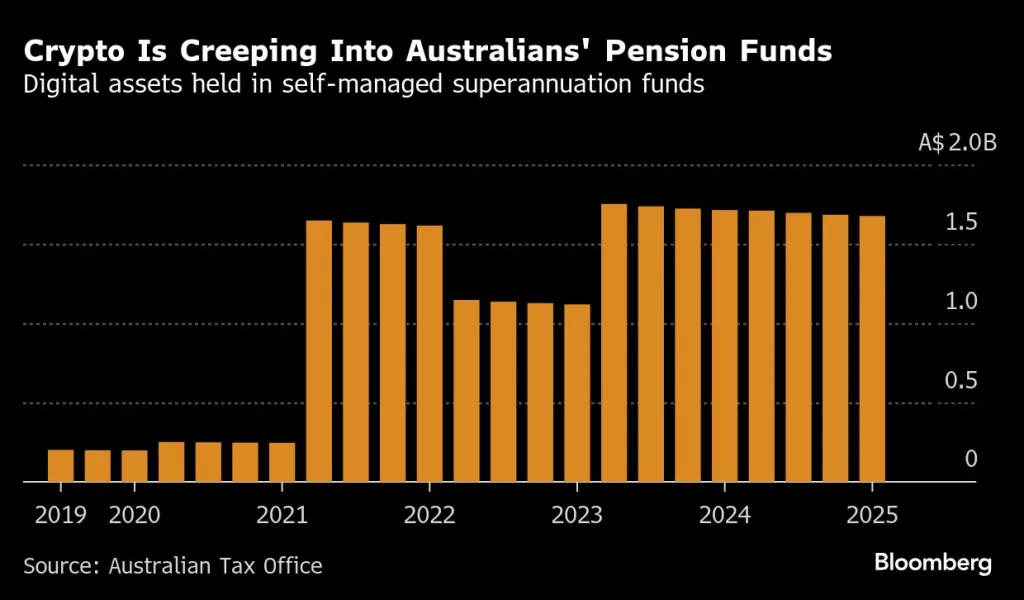Australia’s Superannuation Turns Into a Test Case for Crypto Adoption

- Global exchanges target Australia’s $2.8T pension pool as a gateway for crypto entry.
- SMSFs drive adoption, with crypto exposure jumping sevenfold to A$1.7B since 2021.
- Deloitte projects superannuation could reach $11.2T by 2043 reshaping global finance.
Australia’s superannuation system is fast becoming a critical testing ground for the integration of crypto into regulated retirement savings. Global exchanges Coinbase and OKX are eyeing the A$4.3T ($2.8T) pension pool with new offerings designed to route retirement capital into digital assets.
Superannuation represents Australia’s mandatory retirement savings framework, which is one of the world’s largest investment pools. By September 2024, assets under management totaled $2.7 trillion, more than double the $1.2 trillion recorded a decade earlier.
Superannuation Growth Turns into a Global Crypto Test Case
At an annual growth rate of 8.2%, the system has overtaken the total capitalization of all firms listed on the Australian Stock Exchange. Future growth projections underline its influence. Deloitte projects the fund would reach $11.2 trillion by 2043 in nominal terms, which equals about $7 trillion in today’s dollars.
The scale highlights why global exchanges see superannuation as a potential model for embedding crypto into conservative retirement structures. If successful, the move could reshape institutional attitudes toward digital assets far beyond Australia’s borders.
Cath Bowtell, chair of IFM Investors, explained that $3.2 billion flows into the system each week. This constant inflow requires continuous identification of viable opportunities
Funds already extend across global infrastructure, with investments in toll roads in the United States and ports in Canada. However, liquidity pressures and global market exposure mean diversification remains a pressing concern for fund managers.
Deutsche Bank strategist Lachlan Dynan cautioned against the dangers tied to large-scale foreign exchange hedging. He cautioned that it could expose funds to sudden cash calls during times of crisis. Yet the pandemic revealed superannuation’s resilience when Australians withdrew $38 billion early without destabilizing the broader market.

Source: Bloomberg
SMSFs Drive Crypto Growth as Superannuation Shows Resilience
Self-managed superannuation funds (SMSFs) have become the leading participants in adopting crypto. SMSFs allow individuals to manage their own retirement investments and currently account for about one-quarter of the overall system.
Exposure to digital assets within SMSFs has grown sevenfold since 2021, now totaling A$1.7 billion. The increase reflects a rising appetite for diversification among investors who want more direct control over their portfolios.
Coinbase and OKX are positioning themselves to capture this trend. The platform is developing a specialized SMSF platform and already has more than 500 investors on its waiting list. John O’Loghlen, Asia-Pacific managing director, noted that 80% of applicants want to create new SMSFs, and 77% expect to commit up to A$100,000 in crypto.
Related: Coinbase Adds WLFI’s USD1 Stablecoin to Its Listing Roadmap
OKX launched its SMSF product in June and has reported more engagement than anticipated. Kate Cooper, CEO of the cryptocurrency platform OKX Australia, confirmed that the exchange is connecting investors together with accountants and legal advisors to make fund creation easier.
Although there’s no minimum requirement for SMSFs, the high cost means these structures make sense only for larger portfolios and could be effectively seen as buy-and-hold mechanisms for long-term crypto exposure.
Currently, AMP is the only significant pension provider to come out making a statement on crypto exposure, but momentum in SMSFs may see a wider sector engagement. Australia could be a world leader if mainstream super funds embrace digital assets. This would reflect the potential for pension capital to challenge crypto as a long-term savings investment.
Whether this is a sustainable model or a speculative experiment, the system can be seen as a framework for incorporating digital assets in conservative portfolios. Others, however, believe it could harm the financial stability of those against the idea.




